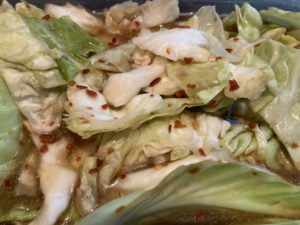
I took a recent trip to San Francisco and was eager to experience its world-class Chinese food. It did not disappoint.
We dined at two places in Chinatown: China Live chinalivesf.com/ and Mr. Jiu’s misterjius.com/.
The former is a large space with several different elements — the ground floor houses a casually elegant open kitchen restaurant-cum-market where you can buy sauces, seasonings, kitchen gadgets and both useful and decorative items. The upper floor offers a formal prix fixe, multi-course dinner. We opted for the downstairs dinner, and the food was truly outstanding.
We certainly enjoy good-quality Chinese food in Philadelphia — those who fondly recall Susanna Foo or Yangming will know what I mean — but even more casual places like Mustard Greens or Lee How Fook deliver high-quality cuisine.
These two places in SF were a cut above. The food delivered complexity and sophistication, not to mention beautiful presentation.
China Live’s dumplings were delicate and flavorful. The fried scallion bread was miraculously light. The Peking duck rolls were melt-in-your-mouth duck breast infused with robustly sweet and spicy kumquat sauce and wrapped in crispy sesame pockets. I don’t even like duck much, and I was enthralled.
Mr. Jiu’s is a Michelin-star restaurant, also in Chinatown. We struggled for a month to get a table and in the end managed to snag 5 p.m. walk-in seats at the bar, where they serve the full menu.
Everything we had was delicious — silken mapo tofu topped with spiced ground beef was our bartender’s recommendation with a warning that it was spicy. We gave it a whirl, despite my lack of enthusiasm for tofu, and it was delicious. We also enjoyed the beef chow fun, rabbit with purple peppers and shishito, and chicken dirty rice.
But the thing that stood out to me, surprisingly, was the Sichuan fermented cabbage. It was sliced into thin ribbons and brought a symphony of flavors — spicy, tangy, funky. I couldn’t stop eating it. I was determined to attempt a recreation at home.
Now I’m no canner, and the idea of sterilizing jars and avoiding botulism is scary to me. Ditto having something fermenting in my kitchen for weeks on end.
But I was determined to make a simpler, user-friendly version of this dish, and I did — soaking cabbage in a spicy vinegar for a few days in the fridge did the trick. It didn’t bring the fermented funk or the tenderness of Mr. Jiu’s, but it delivered a spicy kimchi-esque dish that I have eaten solo, as a side with stir fry, tossed with tuna and heaped on sandwiches. I also saved the surplus vinegar brine — mixed with jarred barbecue sauce — as a delicious chicken marinade and used it to flavor the stir fry below.
Stir-Fried Chicken with Carrots and Snap Peas ala China Moon
Serves 4
Speaking of San Francisco, I have a cookbook given to me by a former colleague that was written by the late Barbara Tropp, chef of the acclaimed San Francisco restaurant China Moon Bistro, a pioneer in the local food movement. The recipe below uses Tropp’s technique, which involves “velveting” the chicken, prepping the aromatics and sauce ahead of time, and blanching the veggies so they quickly cook in the wok. It is a lot of prep ahead of time, I’ll admit, but it makes the assembly of the dinner quite efficient.
You can use any vegetables you have on hand — string beans, broccoli, zucchini, etc. Just be sure to adjust the blanching/cooking time; carrots take some extra time, while zucchini cooks very quickly and becomes mush if overdone.
For the chicken and marinade:
1½ pounds boneless chicken cut in bite-size pieces
1 egg white
1 tablespoon cornstarch
1 tablespoon rice vinegar
1 teaspoon salt
For the aromatics:
2 tablespoons grated fresh ginger
5 cloves garlic, crushed
1 medium onion, minced
½ teaspoon red pepper flakes
For the sauce:
1 cup chicken broth
2 tablespoons soy sauce
1 teaspoon sugar
2 tablespoons vinegar brine from Chinese pickled cabbage (see recipe below) or rice vinegar, or white vinegar
For the vegetables:
4 carrots, cut in coins
1 pint snap peas, stems removed
1 tablespoon canola oil
Chopped cilantro for garnish, if desired.
Prep the chicken: Mix all the marinade ingredients in a sealable container, and add the chicken pieces; stir to coat and let it sit for 3-24 hours in the fridge.
Place the aromatics in a sealable container and set aside. Mix the sauce ingredients in a sealable container and set aside. If longer than an hour, refrigerate both of these mixtures.
Blanch the carrots and snow peas in boiling water for 30 seconds, and then drain. Toss with ice cubes to stop cooking, and set it aside.
When ready to cook, heat a medium-sized pot of water to boil, remove the chicken from the marinade (save the marinade, as it will be added to thicken the sauce later) and submerge the chicken pieces for about 90 seconds. Separate them so they have space to blanch, and then drain them. The chicken pieces will be white outside but raw in the
middle.
In a large skillet or wok, heat the oil and, when it is hot enough to sizzle a bit of onion, add the aromatics and stir until fragrant and the onions are wilting, about 4 minutes. Add the vegetables and stir to coat them with the aromatics, about 3 minutes.
Add the sauce ingredients, and bring them to a simmer; cover and cook 1 minute. Stir the cornstarch/egg marinade and add it to the sauce; continue stirring to thicken the sauce.
Add the chicken, and toss it until it is cooked through, about 3-4 minutes.
Top with cilantro and serve over rice or noodles

Copycat Cabbage
Makes about 2 quarts
1 head cabbage, sliced
¾ cup rice vinegar
½ cup sugar
2 tablespoons soy sauce
2 tablespoons sesame oil
1 tablespoon red pepper flakes
Water
In a small saucepan, heat the vinegar, sugar, soy sauce, sesame oil, pepper flakes and ½ cup water. Bring it to a boil, and set it aside to cool.
Place the cut cabbage in a large, sealable container or jar. When the vinegar mixture cools to room temperature, pour it over the cabbage and add enough water to cover. Seal the container, and place it in the fridge.
It will have some flavor after one day, but it is best to let it sit for about three days for full infusion. It will keep in the fridge, sealed, for about two weeks.






